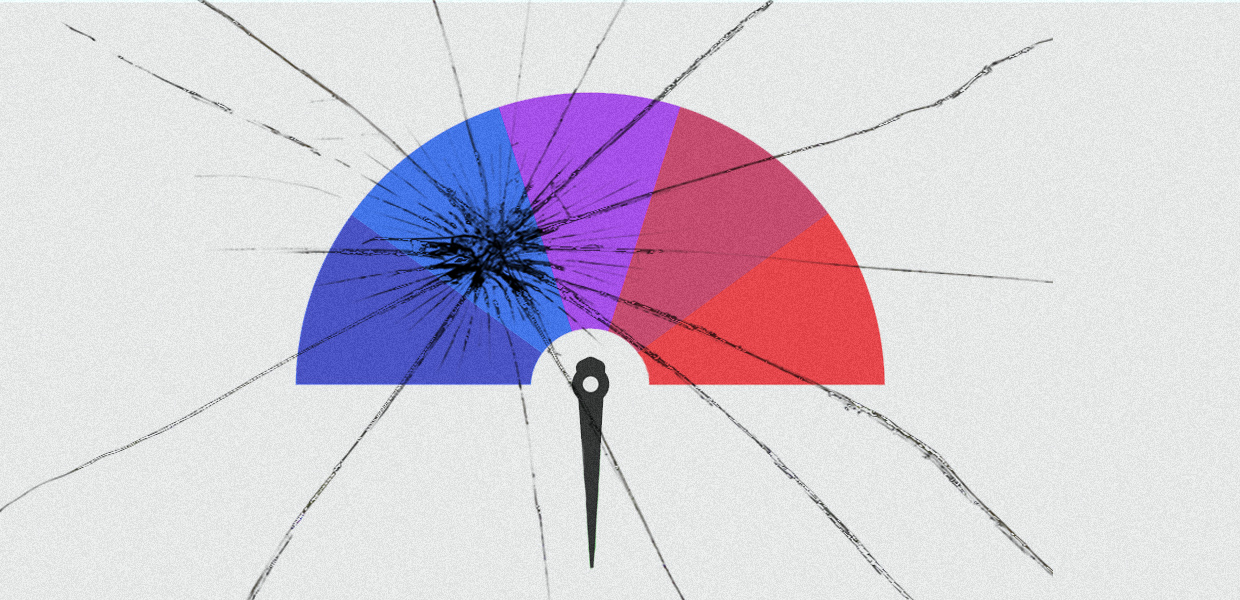The end of the political spectrum
Left, right, and center is obsolete. Now it's top, bottom, and middle.


The time has come to scrap the political spectrum.
Political metaphors help us to make sense of the world around us. The metaphor of left, right, and center has done that for well over two centuries now. We should be grateful that the arbitrary seating arrangements in the National Assembly during the early stages of the French Revolution provided us with such a useful means of ideological orientation for so long. But it no longer does. In fact, the metaphor now obscures more than it illuminates. We need to move on.
In 1789, when partisans of King Louis XVI's authority sat on the right side of the assembly in Paris and reformers sat on the left, no one realized that they were providing the modern world with ideological compass points that would remain fixed for the next 200 years. Yet that's exactly what happened.
The Week
Escape your echo chamber. Get the facts behind the news, plus analysis from multiple perspectives.

Sign up for The Week's Free Newsletters
From our morning news briefing to a weekly Good News Newsletter, get the best of The Week delivered directly to your inbox.
From our morning news briefing to a weekly Good News Newsletter, get the best of The Week delivered directly to your inbox.
At first moderates prevailed. Then the left seized power, leading to The Terror. Eventually the right gained the upper hand, bringing about a restoration of the monarchy. And on it went through much of the 19th century and beyond, with left, right, and center in France fighting over the meaning and legacy of the revolution. Before long, complex ideologies of the extreme left (seeking to expand on the original revolution) and extreme right (aiming for a counter-revolution to reverse the course of modern history) emerged to do battle with a beleaguered liberal center.
The left was defined by its faith in the human capacity to remake politics, economics, and society from the ground up. It marched under a banner of equality and universalism, viewing received norms, practices, and beliefs with suspicion and often hostility. The right, by contrast, insisted that human beings require order and authority in politics, society, and religion. To the extent that these had been swept away by revolutionary passions, they needed to be restored or, where that proved to be impossible, reconstituted from scratch through a mass political movement. At their furthest extremes, the left terminated in communism and the right in fascism, with the liberal center favoring institutions designed to moderate extreme passions and encourage meliorism and ideological compromise.
This schema, like the forms of politics it came so accurately to describe, emerged in France, but it was soon adopted across the world to make sense of the universe of modern ideologies. The Russian Revolution was a triumph of the far left. The Axis powers espoused an ideology of the far right. The United States and Great Britain, meanwhile, oscillated between center-right and center-left governments, never straying all that far from liberalism.
That very moderation always made the European spectrum somewhat less illuminating in the American context. With communism and harder forms of socialism usually favored by very few and thus never gaining much political power, the left came to be defined in the U.S. by the regulated and redistributive but still mostly market-based Keynesian welfare state. The American right, by contrast, was even more distinctive. With no monarchy or established church to restore or reconstitute, American conservatives mixed a vague longing for return to traditional morals and sub-political intermediary institutions (like individual churches and private charities) with a valorization of self-reliance and free-market capitalism. The left came to be associated with a statist mixed economy and the right with laissez-faire libertarianism.
A free daily email with the biggest news stories of the day – and the best features from TheWeek.com
The divergence between the European and American spectrums has sometimes led to amusing and even pernicious confusions — as when American conservatives insist Hitler was a figure of the left because he favored big government or reject Donald Trump (as many did during the GOP primaries of 2016) on the grounds that his defense of some elements of the welfare state is a sign that he's really a liberal. The American left makes an analogous mistake when it describes libertarian-minded Republicans as fascists.
But if the spectrum has occasionally proven unhelpful in the past, today it is downright misleading. The breakdown in its usefulness began with the demise of the Soviet Union. The victory of the allies and defeat of fascism in World War II had already removed the anti-liberal right as a live political option; with the demise of communism, the anti-liberal left was deprived of any viable alternative of its own. In this respect, French historian Francois Furet was absolutely right to proclaim that the French Revolution had finally been brought to a conclusion in 1989, exactly 200 years after it commenced. The dispute over its meaning and import, and clash between the ideological forces it unleashed, was settled. The liberal center had won.
Or so it has seemed for much of the past 30 years. The political ideology that has dominated Western politics over the past few decades, which European critics often call neoliberalism, is a function of the contraction of the ideological spectrum. When there is no far right or far left to speak of, all that remains are center-right and center-left options that overlap in numerous ways. Politics constricts, with debate often boiling down to mild disagreements over minute policy differences. Should taxes be slightly raised or slightly lowered? What's the best way to encourage the economic growth we all favor? How can we nudge people to behave a little better, act somewhat more rationally, become a smidgen more productive, gain a tad bit more purchasing power?
When politics becomes dominated by these sorts of questions, consensus reigns. Politicians might work to accentuate their differences for the sake of electoral gain, but the reality is that whether one centrist party or another comes out on top in a vote matters very little to most people. The consensus will persist. The small-bore policy fiddling will continue, with nothing significant changing.
At least until it does.
The victory of Donald Trump in 2016, like the outcome of the Brexit vote before it, was a bad thing in all kinds of ways. But it was good and important in one big respect: It showed the Western political world that more radical political change — change that breaks sharply from part of the prevailing centrist consensus — is possible. The center-left and center-right in the U.K. are certain that remaining in the European Union is a no-brainer, but slightly more than half of the country showed they disagree. Establishment figures in both the Republican and Democratic parties are strongly predisposed to favor high rates of immigration and free trade, but enough voters were fed up with the consensus that they were willing to give Trump's restrictionist and protectionist approach a try. (Whether he was and is too inept to implement those policies effectively is another issue.)
Are these developments a victory for the far right? The fact that they are being mirrored by parallel moves on what is usually considered the far left should give us pause in describing it that way. Center-right and center-left parties are in sharp decline across Europe. Right-populist parties are rising, but so are left-populists — just as Trump's insurgency from within the Republican Party in 2016 was nearly matched by Bernie Sanders' challenge to Hillary Clinton's center-left bid for the Democratic nomination that same year. Does it make more sense to see these challenges as independent trends? Or to view them as opposite sides of the same coin — different approaches to challenging a still-entrenched but already-weakening centrist establishment?
If the latter is a more compelling way to understand what's happening in our politics, then maybe we need to abandon the inherited left-center-right ideological schema altogether. Maybe the more salient cleavage in our politics is the one that divides those who remain broadly happy with how things have been going from those who do not, those who've been winning from those who've been losing, those who benefit from those who don't, those who've been in charge and running the show from those who've been placed permanently in the role of spectators, assured that those who hold the lion's share of political, economic, and cultural power will earn their privileges by making ours the best of all possible worlds.
In a world defined by this dispute — a fissure separating top from bottom far more than left from right — there would be room to fashion a new center, one no longer defined by its proximity to or distance from the formerly fixed left-right ideological alternatives. Instead, the middle would be defined by wherever a new consensus in public opinion emerges, along with whatever mixture of policies and ideal visions of the country's future end up galvanizing that consensus.
Whatever the outcome of this process, and however long it takes, the old way of conceiving of the alternatives is finished. The old center is dying, along with the old right and left. Long live the new center, whatever it may be.
Damon Linker is a senior correspondent at TheWeek.com. He is also a former contributing editor at The New Republic and the author of The Theocons and The Religious Test.
-
 Political cartoons for December 6
Political cartoons for December 6Cartoons Saturday’s political cartoons include a pardon for Hernandez, word of the year, and more
-
 Pakistan: Trump’s ‘favourite field marshal’ takes charge
Pakistan: Trump’s ‘favourite field marshal’ takes chargeIn the Spotlight Asim Munir’s control over all three branches of Pakistan’s military gives him ‘sweeping powers’ – and almost unlimited freedom to use them
-
 Codeword: December 6, 2025
Codeword: December 6, 2025The daily codeword puzzle from The Week
-
 Has Zohran Mamdani shown the Democrats how to win again?
Has Zohran Mamdani shown the Democrats how to win again?Today’s Big Question New York City mayoral election touted as victory for left-wing populists but moderate centrist wins elsewhere present more complex path for Democratic Party
-
 Millions turn out for anti-Trump ‘No Kings’ rallies
Millions turn out for anti-Trump ‘No Kings’ ralliesSpeed Read An estimated 7 million people participated, 2 million more than at the first ‘No Kings’ protest in June
-
 Ghislaine Maxwell: angling for a Trump pardon
Ghislaine Maxwell: angling for a Trump pardonTalking Point Convicted sex trafficker's testimony could shed new light on president's links to Jeffrey Epstein
-
 The last words and final moments of 40 presidents
The last words and final moments of 40 presidentsThe Explainer Some are eloquent quotes worthy of the holders of the highest office in the nation, and others... aren't
-
 The JFK files: the truth at last?
The JFK files: the truth at last?In The Spotlight More than 64,000 previously classified documents relating the 1963 assassination of John F. Kennedy have been released by the Trump administration
-
 'Seriously, not literally': how should the world take Donald Trump?
'Seriously, not literally': how should the world take Donald Trump?Today's big question White House rhetoric and reality look likely to become increasingly blurred
-
 Will Trump's 'madman' strategy pay off?
Will Trump's 'madman' strategy pay off?Today's Big Question Incoming US president likes to seem unpredictable but, this time round, world leaders could be wise to his playbook
-
 Democrats vs. Republicans: who are US billionaires backing?
Democrats vs. Republicans: who are US billionaires backing?The Explainer Younger tech titans join 'boys' club throwing money and support' behind President Trump, while older plutocrats quietly rebuke new administration
